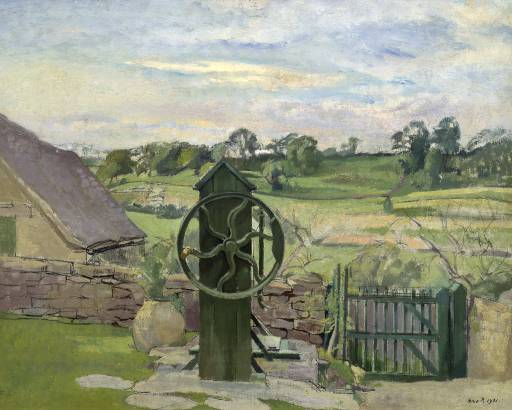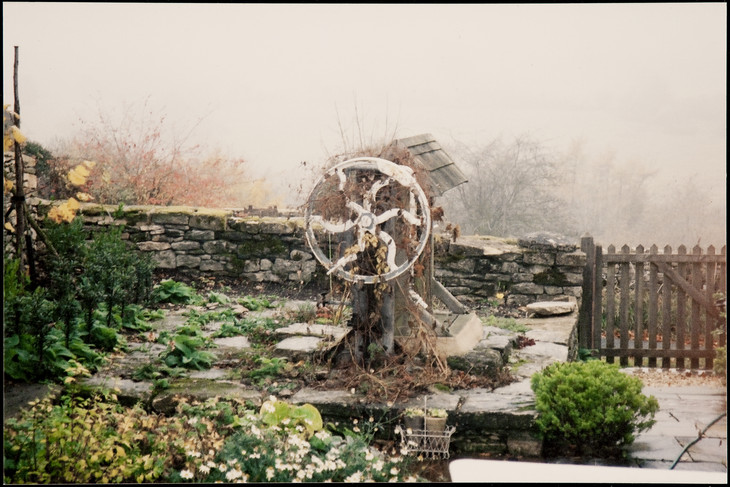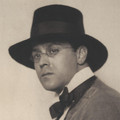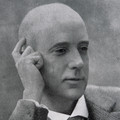Albert Rutherston The Pump, Nash End 1931
Albert Rutherston,
The Pump, Nash End
1931
This oil painting shows a small courtyard and garden enclosed by the walls of Nash Cottage in the village of Bisley near Stroud, Gloucestershire, where Rutherston lived for nearly a decade with his family. The picture takes its name from the green water pump with gold-handled counterbalance wheel in the centre foreground of the canvas, a rustic scene recorded from life. A neighbouring cottage and its slate roof are visible on the left-hand side; the pale green landscape slopes gently away beyond the dry-stone wall and wooden gate.
Albert Rutherston 1881–1953
The Pump, Nash End
1931
Oil paint on canvas
406 x 508 mm
Inscribed by the artist ‘Albert R 1931.’ in black paint bottom right
Purchased (Knapping Fund) 1941
N05258
1931
Oil paint on canvas
406 x 508 mm
Inscribed by the artist ‘Albert R 1931.’ in black paint bottom right
Purchased (Knapping Fund) 1941
N05258
Ownership history
Purchased from the artist 1941.
Exhibition history
1934
Paintings and Drawings by Albert Rutherston, Leicester Galleries, London, January 1934 (72).
1934
XIX Esposizione Biennale Internazionale d’Arte, Palazzo Centrale, Venice, March–October 1934 (British Pavilion, 103).
1939–40
Modern British Paintings, Contemporary Art Society, Ashmolean Museum, Oxford, October 1939–January 1940 (37, as ‘The Pump’).
1941
Painters at Oxford: The Contemporary Art Society, Ashmolean Museum, Oxford, February 1941 (no catalogue).
1942
The Tate Gallery’s Wartime Acquisitions, National Gallery, London, April–May 1942 (73, as ‘The Pump’).
1942–3
A Selection from the Tate Gallery’s Wartime Acquisitions, (Council for the Encouragement of Music and the Arts tour), Royal Exchange, London, July–August 1942, Cheltenham Art Gallery, September 1942, Ashmolean Museum, Oxford, October 1942, Galleries of Birmingham Society of Arts, November–December 1942, Fitzwilliam Museum, Cambridge, January–February 1943, Victoria Art Gallery, Bath, February–March 1943, National Museum of Wales, Cardiff, March–April 1943, Manchester City Art Gallery, April–May 1943, Philharmonic Hall, Liverpool, May–June 1943, National Gallery of Scotland, Edinburgh, June 1943, Glasgow Museum and Art Gallery, Kelvingrove, July 1943, Laing Art Gallery, Newcastle upon Tyne, August 1943 (73).
1946–7
Modern British Pictures from the Tate Gallery, (British Council tour), Palais des Beaux-Arts, Brussels, January–February 1946 (83), Stedelijk Museum, Amsterdam, March 1946 (83), Raadhushallen, Copenhagen, April–May 1946 (83), Musée du Jeu de Paume, Paris, June–July 1946 (83), Musée des Beaux-Arts, Berne, August 1946 (86), Akademie der Bildenden Kunste, Vienna, September 1946 (87), Narodni Galerie, Prague, October–November 1946 (87), Muzeum Narodwe, Warsaw, November–December 1946 (87), Galleria d’Arte Moderna, Rome, January–February 1947 (87), Tate Gallery, London, May–September 1947 (5258).
References
1953
Paintings and Watercolours by Albert Rutherston, exhibition catalogue, Leicester Galleries, London 1953, p.3.
1964
Mary Chamot, Dennis Farr and Martin Butlin, Tate Gallery Catalogues: The Modern British Paintings, Drawings and Sculpture, vol.2, London 1964, p.582.
1988
Max Rutherston, Albert Rutherston, London 1988, pp.vii, 14.
Technique and condition
Rutherston chose a pre-stretched tightly woven linen canvas sized and fully primed with a white ground, which he purchased from the artists’ colourmen Newmans. He painted the scene from life, attaching the canvas to an easel or sketching box in order to work outside, and there remains an area of unpainted canvas at the centre of the top edge where a clamp once held the support in place.
Drawing was an integral part of the image and it occurred at all stages of painting. The artist used a sharp graphite pencil with the aid of a straight edge and compass and the hole made by the point of a compass is left visible at the centre of the pump’s wheel. After initially drawing out the composition in pencil, Rutherston blocked in the main colours in cleanly mixed opaque oil paint, leaving areas of the primed canvas exposed to form the lightest tones, for example, in the foliage and flat stones in the foreground. He chose a simple palette of pre-mixed colours confined to three tones of green, a single blue hue, two brown tones and a single red hue, mixed to an opaque consistency, stiff enough to retain the brushwork. He drew into the paint while still wet to develop the composition, redefine form and delineate pattern. In some areas, the drawing into the paint is left with no further painting, such as the modified side of the barn and the area near trees to the right. The central motif of the pump and the landscape along the horizon is taken to a more finished painted state with developed chiaroscuro and descriptive details, which may have been later touched up in the studio. At a late stage, on the day, he seems to have decided to re-paint the sky while it was still wet and he disturbed existing un-dried layers and formed bumps and ridges in the paint. It is not known whether the artist originally varnished the work but it was certainly left to dry first as varnish has penetrated to the back of the canvas through the compass hole and cracks in the paint.
Roy Perry
July 2004
How to cite
Roy Perry, 'Technique and Condition', July 2004, in Nicola Moorby, ‘The Pump, Nash End 1931 by Albert Rutherston’, catalogue entry, November 2003, in Helena Bonett, Ysanne Holt, Jennifer Mundy (eds.), The Camden Town Group in Context, Tate Research Publication, May 2012, https://wwwEntry
Albert Rutherston worked little in oils between 1912 and 1938 and The Pump, Nash End, is a rare example. Around 1910 he had abandoned the naturalistic ‘New English Art Club’ style of his early career and developed the highly stylised and imaginative manner for which he is best known. From 1912 his artistic output consisted of designs for the theatre and ballet for a brief two-year period, and then predominantly watercolours on silk, book illustrations, watercolour and gouache landscapes, and life drawings. He did not resume oil painting again with any regularity until 1938 when he was introduced by the artist Barnett Freedman to a young art student, Patricia Koring, who was to be his model for a number of late portraits.1 In the intervening years, the very few oil paintings produced by Rutherston were almost all Gloucestershire landscapes, painted in the area surrounding his cottage at Bisley, near Stroud.
As a young man living in London, Rutherston was a committed urbanite, thriving on the social whirl of exhibitions, theatre and dining out with friends. His friend, the poet and writer Humbert Wolfe, described him as a ‘dazzling metropolitan figure’, 2 extremely sociable and well connected, who ‘did not frequent the great world of London, he was the great world of London’.3 In his middle years, however, he seems to have craved a quieter pace of life and towards the end of 1925, he and his wife, Marjory, purchased Nash End Cottage, just outside the small village of Bisley, near Stroud in Gloucestershire. Rutherston wrote to his friend, the novelist Mary Dowdall, in December 1925 that although he intended to keep on his property in Lincoln’s Inn for the present, a move to the country was imminent:
And we intend to spend 6 months there, migrating about 1st March. It’s still in the workers’ hands as we had improvements left to do at once making a spare room of an attic, building a larder etc etc. It’s a dear small place with a lovely studio – typical Cotswold – about 1650. Grey stone & slate tiled roof. Remote & peaceful & beautiful but near enough to the village not to be too lonely.4
In fact, the Rutherstons remained at Nash End for nearly ten years until 1935, during which time the cottage was converted into a comfortable family home to accommodate their two sons, David born in 1925 and Michael born in 1927. Although the location was remote, it was conveniently near enough to Oxford where Rutherston had been employed as an occasional visiting lecturer for the Ruskin School from 1922. In 1929 he was appointed Ruskin Master of Drawing following the death of Sydney Carline (1888–1929).5
The Pump, Nash End was painted from a small courtyard and garden, enclosed on three sides by the walls of Nash End Cottage, and depicts the hillside view of fields and woods visible from the front of the house. A neighbouring cottage with a slate roof stands at the left-hand side of the picture behind a rustic dry-stone wall. This building no longer exists but the main focus of the picture, the water pump standing in the courtyard in front of the wooden gate and wall, can still be seen today (fig.1). The pump is operated by turning the counterbalanced wheel which forces water up from a deep stone well and out of the pipe visible at the right. The well is covered by a wooden trapdoor and a small pitched roof just visible behind the pump. It is possible that by this date the pump was still used as the main water supply for the house and has since been preserved as an interesting and picturesque decorative feature.
Rutherston seems to have had a long-standing affinity with that area of Gloucestershire and its characteristic gentle landscape of woods and fields. During the summer of 1908, in search of peace and quiet following ‘a frightfully busy & altogether chaotic year’, he rented The Manor Farm, Througham, near Cirencester, a ‘lovely old Manor House ... on the side of a hill, a small piece of uncultivated garden all round, then the open fields & the glorious Cotswolds’. 6 An oil painting titled The Lonely Hen, Gloucestershire, and dated 1906 (private collection),7 shows an even earlier connection. Rutherston’s decision to buy Nash End, Bisley, however, was undoubtedly influenced by his brother’s love for this part of the country. Despite having very different personalities, Rutherston and his elder brother, William Rothenstein, shared a close friendship throughout their lives, evident in their correspondence and their tendency to live in near proximity to each other. From 1912 William Rothenstein had lived with his family at Iles Farm, a large building with a substantial amount of adjoining land, at Far Oakridge, a village only a couple of miles south-east of Bisley. Rothenstein’s biographer, Robert Speaight, wrote that having bought Iles Farm, the artist was never again entirely happy away from Gloucestershire.8 Rothenstein wrote to his brother, Albert, from his new house in 1912:
I cannot tell you how happy I am here – all my morbidness slips off me, and I enjoy the gift of life to the full. London simply disappears, and I care no fig for the things which preoccupy me there, stealing so subtly and cowardly into my brain. I warn you that I am only coming back as a visitor – this is where I live my life, the Gods being willing for some time to come.9
In 1920 Rothenstein sold Iles Farm and moved his family back to London for the sake of his children’s education. However, in 1922 he re-established himself nearby when he purchased Winstons, a small cottage in Far Oakridge which he used as a weekend retreat from London and his work as Principal of the Royal College of Art. He eventually retired to Gloucestershire permanently and when he died in February 1945 was buried in St Bartholomew’s Church, Oakridge. Rutherston’s purchase of Nash End Cottage in 1925 must have arisen from a fondness for the area instilled during visits to his brother in earlier years.
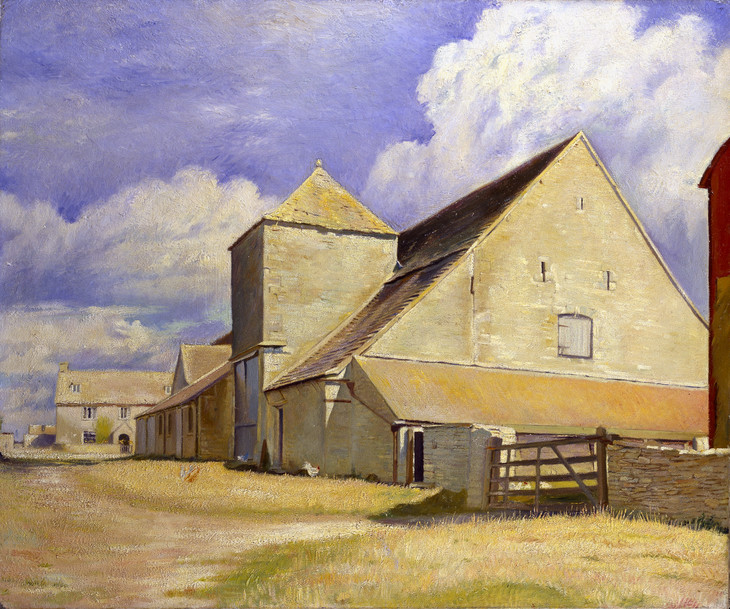
Sir William Rothenstein 1872–1945
Barn at Cherington, Gloucestershire 1935
Oil on canvas
support: 610 x 749 mm; frame: 815 x 939 x 111 mm
Tate N05664
Bequeathed by the artist 1946
© The estate of Sir William Rothenstein. All Rights Reserved 2010 / Bridgeman Art Library
Fig.2
Sir William Rothenstein
Barn at Cherington, Gloucestershire 1935
Tate N05664
© The estate of Sir William Rothenstein. All Rights Reserved 2010 / Bridgeman Art Library
Here it has been beautiful beyond words – such noble clouds day by day; but these have made painting extremely difficult. One takes out a canvas for a sunny subject and lo, the clouds gather; one rushes to a fresh place with a grey effect, and behold, they disperse, and the sun, wooed as a lover, becomes the enemy. Happily, coming here as we do each year, unfinished work can be left for a coming summer ... No poet has ever painted the landscape of Heaven in a convincing manner; one fears the sun may not rise or set there, making lone shadows on the heavenly earth; are there trees, and sloping fields, and little hidden valleys and coombes? Until I know I would rather stay here, and not be hurried away.11
Albert Rutherston’s artistic interests had developed in quite a different direction from those of William Rothenstein, yet he seems to have shared his brother’s interest in painting Gloucestershire’s stone barns and rural countryside for which he eschewed the linear, illustrative manner he had adopted since 1910. In The Pump, Nash End, Rutherston returned to an earlier, more traditional style of landscape painting, seen, for example, in Deserted Farm, Burgundy c.1905 (private collection),12 which was probably painted while in the company of William. The Pump, Nash End reveals a similar picturesque focus on the slightly run-down, weathered look and irregular patterns of the rustic stone buildings and walls. People are entirely absent from the scene, emphasising the peaceful remoteness of the location, but there is a domestic human presence suggested by the water pump and the plant in a stone pot to the left of the well. Rural landscapes were popular during this period among British artists such as Stanley Spencer (1891–1959) and Eric Ravilious (1903–1942) whose paintings often featured agricultural implements integrated into the pastoral landscape. Rutherston has applied the paint in dry patches, blocking in areas of colour but leaving areas of canvas with the underdrawing clearly visible, for example in the trees, the wooden gate and the adjoining wall. This gives the painting an unfinished, rather unpractised appearance and seems to suggest it was painted at speed, en plein air. The critic of the Times described the work as ‘bright in colour and precise in effect rather than in detail’.13
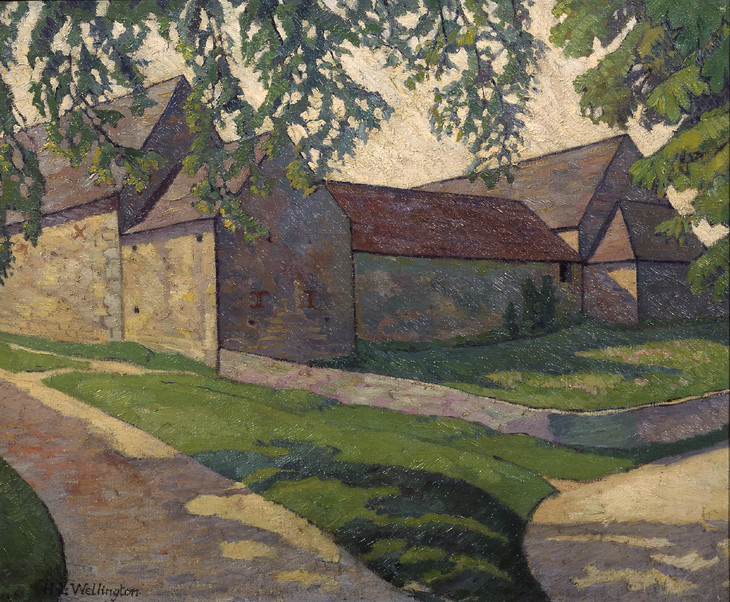
Hubert L. Wellington 1879–1967
The Big Barn, Frampton Mansell 1915
Oil on canvas
support: 508 x 616 mm
Tate T00448
Presented by the Trustees of the Chantrey Bequest 1961
© The estate of Hubert L. Wellington
Fig.3
Hubert L. Wellington
The Big Barn, Frampton Mansell 1915
Tate T00448
© The estate of Hubert L. Wellington
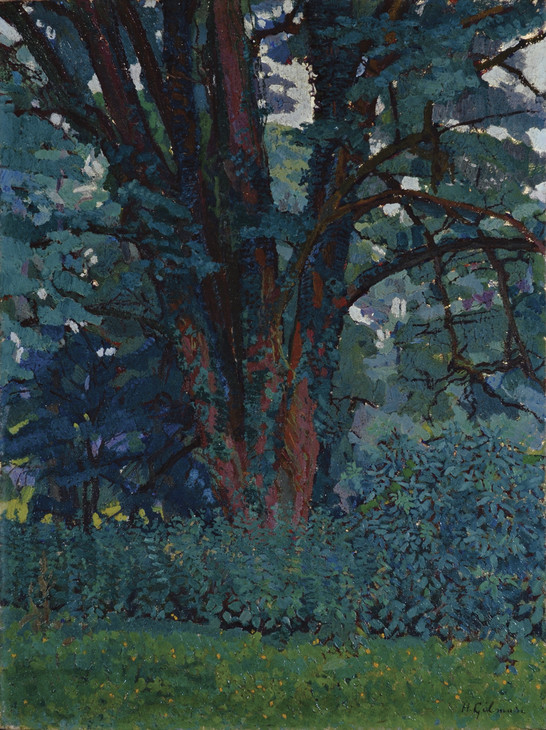
Harold Gilman 1876–1919
In Gloucestershire 1916
Oil paint on canvas
597 x 463 mm
Leeds Museums and Galleries (City Art Gallery)
Photo © Leeds Museums and Galleries (City Art Gallery) UK / The Bridgeman Art Library
Fig.4
Harold Gilman
In Gloucestershire 1916
Leeds Museums and Galleries (City Art Gallery)
Photo © Leeds Museums and Galleries (City Art Gallery) UK / The Bridgeman Art Library
Other Gloucestershire subjects by Rutherston include Evening Study, Nash End (gouache),14 In a Beech Wood, Gloucestershire, Orchard in Gloucestershire, The House in the Wood, Gloucestershire,15 and the watercolour, Frampton Mansell, Glos.16 (all whereabouts unknown). Frampton Mansell is another Cotswold village very close to Bisley and Far Oakridge, which featured in the work of Hubert Wellington (1879–1967). Wellington was a painter, lecturer and writer on art who was a contemporary of Rutherston’s at the Slade and later became Registrar at the Royal College of Art under William Rothenstein. He was brought up in Gloucestershire and painted the village on a number of occasions between 1915–16,17 for example, The Big Barn, Frampton Mansell 1915 (Tate T00448, fig.3), exhibited at the London Group in 1916.18 Although never a member of the Camden Town Group, Wellington was friendly with Walter Sickert, Spencer Gore and Harold Gilman and he frequently sent pictures to London Group exhibitions. His paintings reveal a sympathy with Camden Town Group artists in their treatment of everyday subjects painted with an awareness of post-impressionist colour and form. In the summer of 1916, Gilman stayed with Wellington in Sapperton and produced a number of paintings of trees, with an emphasis on colour and formal design, for example Beech Wood, Gloucestershire 1916 (York City Art Gallery)19 and In Gloucestershire 1916 (fig.4). This small and rather isolated area of the country was the site of much artistic activity in the early twentieth century. Ernest Gimson (1864–1919) and the brothers Ernest (1863–1926) and Sidney Barnsley (1865–1926) had established the area as an important centre of Arts and Crafts furniture-making when they moved their workshop from London to the area in 1892.20 Gimson designed a cupboard for William Rothenstein which was richly decorated with hand-painted local scenes by Alfred Powell.21 The Pump reflects some of the characteristics of the Arts and Crafts movement in its emphasis on local hand-built dry-stone walls, the traditional pump and their harmonious existence within the tamed but historic farm landscape.
The artist’s grandson Max Rutherston has pointed out that The Pump is the only work by Albert Rutherston to have been purchased by the Tate Gallery directly from the artist.22 The painting is an unusual choice for such a distinction due to its sketchy, unfinished appearance and the fact that it is stylistically unrepresentative of the majority of Rutherston’s work at this time. Rutherston himself admitted that the painting was ‘a small affair only, even when framed’.23 The painting had a history of exhibition prior to its purchase in 1941, including an appearance in the British Pavilion of the 1934 Venice Biennale. The selection was designed to illustrate the stylistic variety in British art at the time and included artists as diverse as Ben Nicholson, Vanessa Bell, C.R.W. Nevinson, Arnesby Brown and David Jones. However, it is no coincidence that the date of the purchase of the painting for the collection of the Tate Gallery follows the recent appointment as director of Rutherston’s nephew, John Rothenstein (1901–1992, Director 1938–64). In fact the idea of one of Rutherston’s paintings being purchased for the collection seems to have been initiated by the artist himself and may have been accepted as a gesture of appreciation and gratitude by his nephew for Rutherston’s continued support and encouragement.24 Nevertheless, the choice of work is a surprising and rather uninspiring one. It is possible that it was accepted as an example of traditional British landscape painting and its tranquil, rural theme may have held a greater appeal to viewers during the Second World War, particularly in London at the height of the Blitz.
Nicola Moorby
November 2003
Notes
William Rothenstein, letter to Albert Rutherston, 31 December 1912, quoted in Mary M. Lago and Karl Beckson (eds.), Max and Will: Max Beerbohm and William Rothenstein, their Friendship and Letters, 1893 to 1945, London 1975, p.71.
Paintings and Drawings by Albert Rutherston, exhibition catalogue, Leicester Galleries, London 1934 (88).
Fifth Exhibition of Works by Members of the London Group, Goupil Gallery, London, June 1916 (19, as ‘The Big Barn’).
Related biographies
How to cite
Nicola Moorby, ‘The Pump, Nash End 1931 by Albert Rutherston’, catalogue entry, November 2003, in Helena Bonett, Ysanne Holt, Jennifer Mundy (eds.), The Camden Town Group in Context, Tate Research Publication, May 2012, https://www

